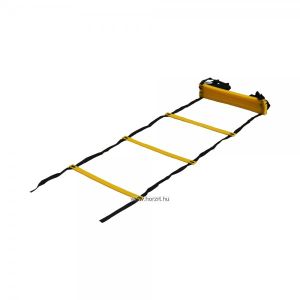Zita Hajdúné Petrovszki, Gizella Cziberéné Nohel, Mihály Domokos, Andrea Hézsőné Böröcz, Ágnes Hocza, Emese Meszlényi-Lenhart, Beáta Vári: New tools in the service of everyday physical education
The coordination ladder

The coordination ladder is a tool suitable for the implementation of the Dynamic system method (DSA) in learning movement.
1-2 grades
- The pupils move over the ladder on all fours, sideways. The task will be performed in both directions.
- The pupils move forward on the bars of the ladder on all fours, swinging the limbs on the same side of the body.
- See the task over; the pupils swivel the limbs on the opposite sides of the body.
- Bunny hop into every square of the ladder.
- Mowing on all four over the ladder.
- Running to and fro, stepping into every square, then handing the ring off to the partner.
- Moving forward on both legs or on one leg, hopping in every square of the ladder.
- Running sideways, lifting the knees, two feet in each square.
- Hopping forward, with a quarter-turn in every square.
- Running over the ladder forward and backward, feet apart.
- Walking on all four over the ladder.
- Running and lifting the knees, gravity center high, middle and low.
- Running, stepping once in every square.
3-4 years
- Do push-ups and move sideways, both hands in each square.
- Front push-ups, one hand in the first square, the other in the second square. With a swift movement of the arms turn to the reverse push-ups and continue moving, then turn back to front push-ups, etc.
- See the task above; the feet are between the squares of the ladder.
- Move on all fours over the ladder. The arms move between the squares of the ladder, while the legs move outside. The same can be repeated with the legs moving between the squares of the ladder, and the arms moving outside.
- Move on all fours over the ladder backwards.
- Doing a wheelbarrow walk-out, hands in every square (taking into account spine protection, pull your knees under your trunk)
- Running over the ladder, stepping in every square, running backwards over low hurdles.
- See the previous task; in addition, passing on a vest
- Jump on both legs from the first square to the second, then move forward, doing jumps, spreading and closing your feet.
- Run, stepping in every square once, twice or three times.
- Jump in the first square on both legs, then out, beside the second square, on spread legs.
- Jumping on both legs sideways, in both directions.
- A competition of a standing long jump. The further square you reach, the more points you get.
- Jumping on one leg, moving from square to square.
- Jumping twice on the left leg then on the right leg. Jump in every square or in every second square.
- Walking on all four, in pairs, synchronized, on both sides of the ladder, stepping into the squares with your limbs (accommodation).
5-6 years
- Move sideways doing push-ups, using your arms according to the direction of movement (reaching across)
- Two ladders are arranged in parallel. The movement takes place to the side. You do front push-ups, one hand in the first square of the fist ladder, the other hand in the second square of the second ladder, while the legs are in the squares on the other ladder. With a swift moment, you turn round to the reverse push-up position according to the direction of the movement, and continue moving. The position of the arms and legs is determined by the squares of the ladders.
- Doing a wheelbarrow walk-out, moving sideways (taking into account spine protection, pull your knees under your trunk)
- Do spider and crab walk over the ladder. The arms and legs find support in the squares.
- Running over the ladder, stepping in all the squares, that over three high hurdles, situated at an equal distance from one another, then a slalom run back between the cones. The ring can also be used.
- Jumping on both legs in the squares of the ladder, twice forward, once backward.
- Jumping on both legs mowing sideways (it can be made more difficult with various circular movements of the arms)
- A standing long jump. After the first landing another jump follows. The goal: to accomplish the length of the ladder with the minimum number of jumps.
- Moving sideways while doing front push-ups. Move forward simultaneously using limbs on the same side of the body.
- Jumping on both legs to the side 2 degrees, then 2 degrees to the front, then 2 degrees to the opposite direction, etc.
- Running sideways, raising your knees, with different circular movements of the arms.
- Carry out the above exercises to music or to a rhythmic beat given by the teacher or another participant.
- Dribbling the ball next to the ladder and walking over it.
- Dribbling the ball over the ladder (bouncing the ball in every second square), moving forward.